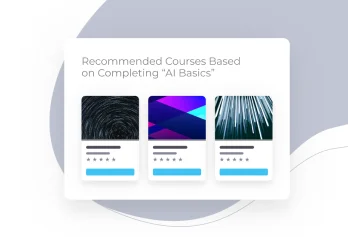We all like to be rewarded for a job well done. And employers want jobs to be done well. But which has to come first? With a well-established employee recognition program, you don’t need to answer that question.
When learners are recognized for their work, they’re incentivized to make further contributions. Whether it’s a feeling of accomplishment, recognition from peers, one place higher on the leadership board or a certification that gets you one step closer to a promotion. When it comes to promoting learning, the carrot is always mightier than the stick.
With limits imposed by budgets and resources, and a remote or dispersed workforce, what's the best way forward? From on-the-spot shout-outs to informal and formal rewards programs, we’ve got you covered in this blog. Read on to learn about:
- The importance of employee recognition (in case your leaders need a little persuading)
- Different types of recognition (if your learning programs aren’t one-size-fits all, neither should your employee recognition programs)
- 7 best practices to keep in mind when setting up a new initiative, or revamping an old one
- How to scale recognition programs to external audiences (it’s time to start giving your customers some love)
Take this blog as your sign to recognize someone on your team, direct report or peer (even your manager, because even they need a little love sometimes too), for something they’ve done recently!
Why is employee recognition so important?
Employee recognition is sometimes treated like a nice-to-have rather than a foundational element of L&D programs. This, as you know dear reader, is wrong. Recognition is an integral part of the employee experience. When learners are rewarded for active participation and their overall contributions, it reinforces positive behavior and gives them a sense of ownership and accomplishment. And if you look over the long term, it’s not just immediate learner outcomes that benefit, it’s got business benefits too.
Enhance employee engagement
Learner engagement came out as the #1 learning challenge learning teams face today in the State of Learning; ahead of reporting and analytics, content creation and measuring the ROI of learning.
If you want to see more engagement from your learners, you need to recognize (and incentivize) that behavior. Create a loop where you incentivize your learners to actively participate, provide a framework for them to follow, encourage them to be invested in their own learning, and reward them for their contributions. And just like that, you’ll be on your way to significantly improving your employee engagement.
Boost workforce morale
Recognition programs foster a sense of belonging and connection, helping to create an inclusive culture where employees not only feel valued, but respected. When your work environment is positive, you’ll have higher rates of job satisfaction among employees contributing to a stable and committed workforce and positively impacting those employee attrition rates.
Build a culture of learning AND appreciation
Learning and culture. Culture and learning. They’re closely intertwined and are both powerful motivators to inspire employees to excel in their roles and take pride in their work. Recognition programs foster a sense of belonging and connection, creating an inclusive culture where employees feel valued and respected. Another way to stem employee attrition.
What are the different types of recognition?
Tangible rewards are at the core of every employee recognition program. But recognition doesn't need to take the form of money or objects. A simple thank you can get you a long way. Pivot your thinking toward recognition that invests in your people as, well, people. Doing so will open up learning pathways to nurture, engage and energize your workforce. Whichever you choose tailor recognition to individual preferences and achievements to make it more meaningful and impactful.
Manager-to-employee recognition
When was the last time your manager recognized your contribution? If you can’t remember, it’s been too long. This type of recognition can take various forms, whether it’s verbal praise or a written note of appreciation, it just needs to be specific and given in the moment. This is one of the simplest ways managers can strengthen their bond with team members.
Peer-to-peer recognition
Facilitate peer-to-peer recognition to create a culture of appreciation and support among colleagues. This will encourage employees to learn from each other by making coaching a part of your learning program recognition strategy. For example, let an employee who was recognized for the way they handled a difficult conversation lead the discussion component of an upcoming training event, or provide feedback on training pathway assignments within the LMS. Learning recognition incentives send a clear message that an organization values their employees and supports a culture of continuous improvement.
Cross-departmental recognition
No team is an island, but sometimes we forget just how many other teams we work with to achieve our goals. In your next all-hands meeting, take a top-down approach and get each departmental leader to acknowledge a certain team’s contribution to that quarter's successes. After all, we want our leaders to exhibit the behaviors expected from the wider workforce.
When and how
As you consider the best way to recognize your employees, keep in mind the best times and places to highlight their success. Establish a routine and share it with the team. Let them know where, when and how they will be acknowledged. As you implement an employee recognition strategy, stay focused and be clear about merit. Everyone deserves a chance to stand in the limelight!

Leadership boards
A little bit of competition can go a long way in acknowledging and celebrating achievements and contributions. Many employees will up their learning output to get the coveted title of learner of the month, and if you set up team challenges it’ll help your employees bond as they plot total domination of the winner's league (no one minds who wins, as long as it’s not Sales, right?). While it’s just meant to be a little bit of fun, it’s also a way to show transparency in your recognition practices, instilling a sense of fairness and equality among employees.
Professional development opportunities
Promotions aren’t the only way to show that you value employee growth or take investing in personal and professional advancement seriously. These opportunities are particularly important in remote environments, where what might have happened naturally due to proximity or by speaking to the right person over lunch, now need to be formalized:
- Enhance skills through cross-functional stretch projects
- Provide networking opportunities for career advancement
- Recognize potential with targeted mentorship programs
Rewards programs
Tangible incentives and rewards always have and always will play a role in showing appreciation. Cash bonuses and gift cards are one way to go, but an afternoon off or the chance to go to a conference will stick in the memory a lot longer than whatever you were able to buy from your company shop.
What are the best practices for recognition?
Think about what you want to achieve through your employee recognition program. Whether you're hoping to motivate performance, facilitate growth potential, reinforce new behaviors or inspire innovation, providing learning and advancement opportunities will have a far greater impact than a company water bottle.
- Clear objectives: What’s the goal? To improve employee morale, increase motivation, or drive specific behaviors? Your objective will inform your strategy. Be sure to define the objectives of the recognition program, provide training, and communicate its importance to ensure employees feel motivated to participate.
- Inclusive criteria: Establish clear and inclusive criteria for recognition to ensure fairness and transparency in a companywide program.
- Frequent and timely recognition: Provide regular and timely recognition to reinforce positive behaviors and achievements. Establish one centralized recognition platform, and dedicate a channel or pathway to employee recognition. Email? Collaboration tools? Meetings? Townhalls? (The answer can be all of the above.)
- Variety of recognition methods: Offer a different types of recognition methods, such as verbal praise, certificates, awards, or if the budget extends this far, monetary incentives, to cater to different preferences and motivations.
- Continuous feedback: Gather feedback from employees to evaluate the effectiveness of the recognition program and make improvements as needed. People rarely get anything completely right the first time around. It’s all about listening, remaining flexible and iterating.
- Alignment with organizational values: Ensure your recognition program aligns with the organization's core values and goals to reinforce desired behaviors and outcomes.
- The easiest and often overlooked best practice? Asking your learners how they like to be appreciated. When they go through their onboarding, just add a section (like the example below) as part of the getting to you know better documentation by asking how they rank different forms of recognition. Share that feedback with their manager and when the time comes to recognize them for some exceptional learning you have guidance on what is meaningful to them.
Least important | Somewhat important | Important | Very important | |
|---|---|---|---|---|
Verbal words of thanks given privately | X | |||
Verbal recognition given publicly | X | |||
Written note of appreciation | X | |||
Written recognition from my supervisor | X | |||
Company branded items/clothing | X | |||
Gift certificates | X | |||
Team celebrations | X | |||
Organizational celebrations | X | |||
Development opportunities | X |
Other questions you can include to further personalize any recognition:
- Big existential questions for long-term development opportunities and recognition: What’s your biggest motivator? What are your personal goals?
- Personal questions for quick wins and immediate recognition: What’s your favorite drink order? What’s your favorite take-our order and from where? Who’s your favorite sports team?
Not all recognition needs to be performance-based or tied with learning milestones, sometimes it’s just nice to be appreciated. For example, work anniversaries are a great time to show a little no-strings attached appreciations.
Next steps: Engage and motivate external learners through recognition
Once you’ve got your internal learners covered, why not take a look at external learner-focused recognition programs too? Engaging and motivating external learners helps to build strong relationships and showcase the value of your training programs to a broader audience. Here are a few ways you could start to better recognize your customers:
- Certifications: We all like a badge or something to post on LinkedIn, so why would customers be any different? Tap into your customers intrinsic motivations and let them earn certifications through training, assessments, or examinations that demonstrate their proficiency and credibility in a specific subject or skill. The fortunate byproducts of this? Customer loyalty and product usage.
- Awards: Formally acknowledging and celebrating customers who’ve demonstrated exceptional loyalty, advocacy and innovation goes a long way. Whether it’s a trophy they can put on their desk or snazzy awards ceremony, (however small), it’s a tangible way to express your appreciation and acknowledge the valuable role your customers play. Plus, you’re giving them bragging rights for the great work they’re doing.
- Guest speaker opportunities: Inviting customers to do guest speaking spots at events as part of customer recognition programs is an effective way to showcase customer success, inspire others, and build a strong community of engaged and loyal customers. They're also the best brand advocates for you with potential customers being more likely to trust the word of satisfied customers than one of your paid ads.
- Referral awards: Just like with employees, sometimes a little monetary compensation can go a long way. Incentivizing and rewarding customers for recommending your business can be a great investment in the right circumstances. There are mutual benefits similar to other forms of recognition, and your AMs won’t be complaining if they can have a few of these in their back pocket right around renewal season too.





